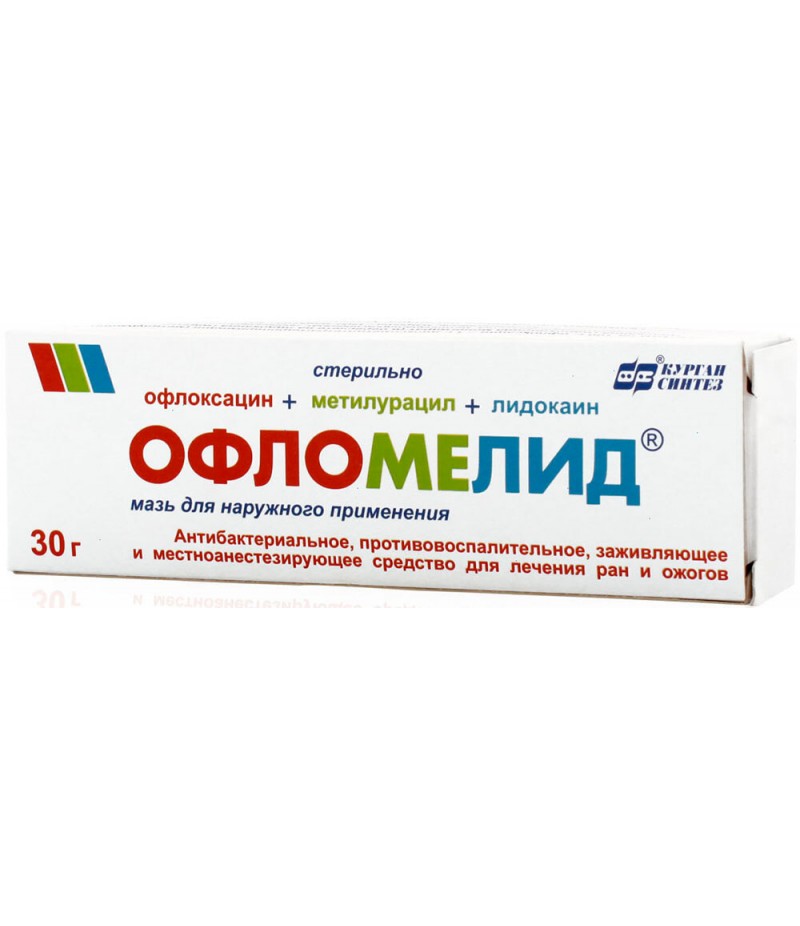Oflomelide ointment 30gr
- $7.72
- 3 or more $7.55
- Availability:In Stock
Instruction for OflomelideReed more and buy Oflomelide hereCompositionOflomelide ointment contains 3 active components: ofloxacin in a dose of 10 mg; Lidocaine hydrochloride in the form of monoh..
Tags: ointment
Instruction for Oflomelide
Reed more and buy Oflomelide here
Composition
Oflomelide ointment contains 3 active components:
ofloxacin in a dose of 10 mg;
Lidocaine hydrochloride in the form of monohydrate in an amount of 30 mg;
methyluracil 40 mg.
Additional components: methylparahydroxybenzoate, macrogol 400 and 1500, propylene glycol, propyl parahydroxybenzoate.
Form of issue
The white ointment is packed in cans of polymer (200 and 400 grams), aluminum tubes (30 g each) and jars of dark color (1000/2000 g). In a pack of cardboard is an instruction from the manufacturer with recommendations and 1 tuba / bank.
pharmachologic effect
Medication with antimicrobial, topical anesthetic, anti-inflammatory and regenerative activities, which are provided by components included in Oflomelide.
Ofloxacin belongs to the group of fluoroquinolones and has an antimicrobial effect, which is manifested in relation to most microorganisms. Due to the blockade of the DNA-gyrase enzyme, a bactericidal effect develops in the microbial cell. The drug acts on staphylococci, anaerobes, chlamydia, escherichia coli, legionella, mycoplasmas, pseudomonas, streptococci, proteins and other microorganisms.
Metiuracil is able to stimulate regenerative processes in tissues. Anabolic activity is manifested. The active ingredient is able to accelerate epithelization, granulation tissue maturation and growth, accelerate cellular regenerative processes in wound injuries.
Lidocaine is known for its local anesthetic effect, which is achieved by blocking sodium channels and impeding pulsed generation in the endings of neurons of sensitivity. The active substance prevents transmission of a pain impulse along nerve fibers. Local irritating effect is not manifested with external application. The active substance is able to expand the lumen of the vessels.
Hyperosmolar (hydrophilic), water-soluble basis of the ointment is a mixture of polyethylene glycols (polyethylene oxides), whose molecular mass is 400-1500 units. The base provides a moisture-absorbing, dehydrating effect when applied to fabrics. In comparison with a solution of sodium chloride (10%), the force of the hyperosmotic action of the ointment base is 20 times stronger.
Pharmacodynamics and pharmacokinetics
The manufacturer does not provide a description of pharmacodynamics and pharmacokinetics.
Indication, application of Oflomelide
Antimicrobial agent is prescribed for purulent, infected wound lesions of different etiology and localization in the purulent-necrotic (first) phase of the wound process, including with concomitant pain syndrome:
trophic ulcers;
pressure sores;
infected burns 2-4 degrees;
wounds after operative opening of phlegmon and abscesses;
after surgical treatment of hydradenitis, carbuncles, abscessed furuncles, suppurated with lime and atter;
post-traumatic and postoperative fistulas and wounds.
Contraindications
lactation;
pregnancy;
individual hypersensitivity;
restriction on age - up to 18 years.
Side effects
In predisposed patients, allergic responses may develop.
Oflomelide, instructions for use (Method and dosage)
Ointment is applied only externally, the frequency is 1 time per day, the duration of therapy is 7-14 days. The course is determined on an individual basis, depending on the dynamics of cleaning the wound surfaces from purulent exudates, reducing the inflammatory process. The maximum daily allowable dose of the ointment is 100 mg.
After treatment of burn and wound surfaces from the mud, a thin layer is applied to the ointment, after which a sterile gauze bandage is applied. It is possible to apply a dressing from gauze with subsequent application to the wound center.
With cavitary purulent wounds, it is recommended that they be loosely filled with special tampons impregnated with ophthalmic ointment. In the fistulous passages introduce turundas from gauze with ointment.
With infected burn wounds, the drug is applied 2-3 times a week or more often depending on the volume of the purulent discharge.
Overdose
The manufacturer does not describe cases of overdose when applying the medicament in large quantities to the skin.
Interaction
The change in the effectiveness of Oflomelide itself and other drugs with their simultaneous therapy is not documented. The drug does not affect the safety of other medicines.
Storage conditions
Tubes made of aluminum, cans of polymer and glass can be transported and stored under temperature conditions (15-25 degrees).
Shelf life - 2 years.
special instructions
The drug does not affect the ability of the patient to manage complex mechanisms, vehicles.
Children
Oflomelide can be used in pediatric practice at the age of 18 years.
In pregnancy and lactation
Feeding and pregnancy are absolute contraindications to the use of medication (it is possible to get active components into the systemic blood stream when treating wound surfaces).
Reviews about Oflomelide
Ointment is actively appointed by surgeons, traumatologists, kboustiologami, tk. allows in a short time to prevent infection and suppuration of wound surfaces.
Patients note that the drug is convenient to use, has no specific smell, well anesthetizes and helps to close wounds and burns. The drug works well for furunculosis, trophic ulcers and pressure sores.

